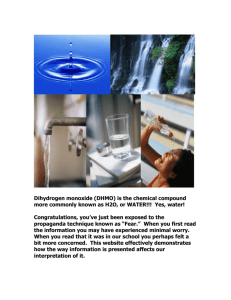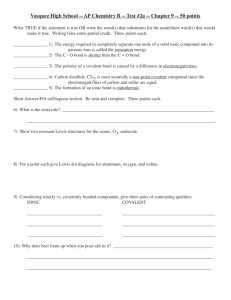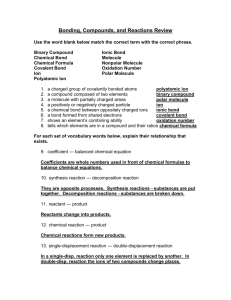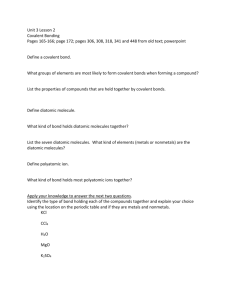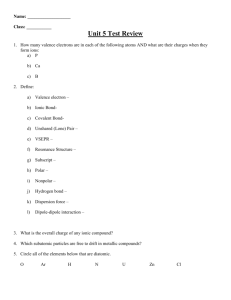Today is
advertisement
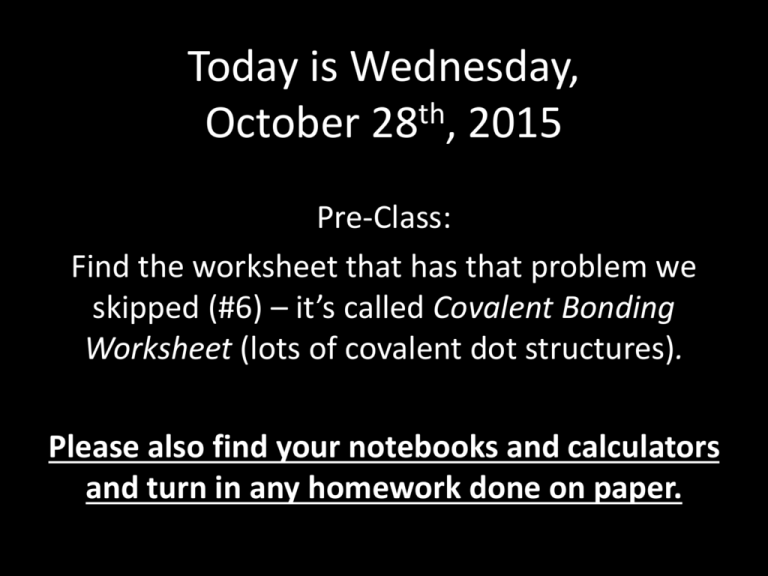
Today is Wednesday, th October 28 , 2015 Pre-Class: Find the worksheet that has that problem we skipped (#6) – it’s called Covalent Bonding Worksheet (lots of covalent dot structures). Please also find your notebooks and calculators and turn in any homework done on paper. Today’s Agenda • • • • Review Review Institutionalized discrimination? Review Review Game Rules • I will ask a question to the class. • Each participant (that’s you) writes down the answer silently. – Not each group…each individual. • After a few moments, I will say, “Compare answers.” • Each of you will look at what the other wrote. Review Game Rules • Did you each get the right answer? – 2 points. • Did one of you get the right answer? – 1 point. • Neither of you? – For shame. 0 points. – And eternal guilt. Review Game Rules • The List of Do Nots: – Do not talk to each other, make noises, gesture, give answers (my discretion here) between when the question has been read and when I say, “Compare answers.” • Doing so will result in a disqualification for that round. Don’t believe me? Try it. – Do not fall asleep when I’m getting scores. • If you’re not paying attention, I’m not giving you points. Review Question 1 • Calculate the total bond dissociation energy for a molecule of CO2. • C—O – 360 • C=O – 736 • O=O – 498 • 1472 (736 + 736). Review Question 2 • Why is NH4+ tetrahedral while NH3 is trigonal pyramidal? – NH4+ (ammonium ion) has four bonding atoms and no unshared pairs. NH3 (ammonia) has three bonding atoms and one unshared pair, forcing the pyramidal shape. Review Question 3 • What kind of bond exists between sodium and sulfur? – Ionic. Review Question 4 • What is the formula for the bond between sodium and sulfur? – Na2S. Review Question 5 • What is the name of the compound between sodium and sulfur? – Sodium sulfide. Review Question 6 • How many electrons does each sulfur give away as the compound forms? • 0. Review Question 7 • How many electrons does each sulfur receive as the compound forms? • 2. Review Question 8 • What is the charge on each sulfur atom? • 2-. Review Question 9 • What is the charge on each sodium atom? • 1+. Review Question 10 • BONUS NON-CHEMISTRY QUESTION – With a link to chemistry. • You may wager any/all of your points. • Category: Investing • Which company has the same stock-ticker symbol as the symbol for fluorine on the periodic table? – Ford Motor Company. Review Question 11 • What kind of bond exists between an oxygen atom and two hydrogen atoms? – Covalent (or molecular) bond. Review Question 12 • Are the bonds single, double, triple or a combination of the three? – Single. Review Question 13 • What is the name of a compound with the formula H2O according to the traditional naming system we’ve learned in this class? – Dihydrogen monoxide. Review Question 14 • How many total valence electrons are there in dihydrogen monoxide? – Eight. Review Question 15 • How many unshared pairs AND bonded atoms are there in a molecule of dihydrogen monoxide? – 2 unshared pairs. – 2 bonded atoms. Review Question 16 • According to VSEPR theory, what shape does a molecule of dihydrogen monoxide take? – Bent. Review Question 17 • What’s the name of dihydrogen monoxide (in our daily lives)? – Water. Review Question 18 • BONUS NON-CHEMISTRY QUESTION • You may wager any/all of your points • Category: Political History • Apartheid was a significant sociopolitical dividing system in place in which country from 1948 to 1993? – South Africa. Review Question 19 • What is the name of this compound? PbF2 – Lead (II) fluoride. Review Question 20 • What is the name of this compound? NO – Nitrogen monoxide. Review Question 21 • What is the name of this compound? BaCO3 – Barium carbonate. Review Question 22 • What is the name of this compound? H2CO3 – Carbonic acid. Review Question 23 • What is the name of this ion? Ca2+ – Calcium ion. Review Question 24 • What is the name of this ion? F– Fluoride ion. Review Question 25 • What is the name of this ion? Co3+ – Cobalt (III) ion. Review Question 26 • What is the name of this compound? HF – Hydrofluoric acid. Review Question 27 • BONUS NON-CHEMISTRY QUESTION • You may wager any/all of your points. • Category: Literature • Who wrote the Sherlock Holmes series? (Note: You can receive credit with only a last name) – Sir Arthur Conan Doyle. Review Question 28 • Is the bond between carbon and oxygen a polar covalent bond? • Carbon Electronegativity: 2.5 • Oxygen Electronegativity: 3.5 – Yes. Review Question 29 • How many unshared pairs of electrons are there in a molecule of carbon dioxide? – None. Review Question 30 • According to VSEPR theory, what shape does a molecule of carbon dioxide take? – Linear. Review Question 31 • Is a molecule of carbon dioxide polar or nonpolar? – Non-polar. Though each bond is a polar bond, the linear, symmetrical shape makes the whole molecule non-polar. The polarity “cancels out.” Review Question 32 • BONUS NON-CHEMISTRY QUESTION • You may wager any/all of your points. • Category: 20th Century History • The Cuban Missile Crisis occurred while which President was in office? – Kennedy. Review Question 33 • Which types of molecules do not have London Dispersion forces? – None. They all do. Review Question 34 • When would you expect to encounter dipoledipole interactions? – With polar molecules. Review Question 35 • Hydrogen bonding occurs when an atom of hydrogen is directly bonded to one of which three atoms? – Nitrogen, Oxygen, or Fluorine. Review Question 36 • Would CCl4 make a crystal, polar covalent bond, or non-polar covalent bond? – Non-polar covalent bond. Review Question 37 • According to VSEPR theory, what molecular shape would CCl4 take? – Tetrahedral. Review Question 38 • What is the name of this compound? CdCl2 – Cadmium chloride Review Question 39 • What kind of bond exists between zinc and copper? – Metallic. Review Question 40 • BONUS NON-CHEMISTRY QUESTION • You may wager any/all of your points. • Category: U.S. Presidents • Name three of the four U.S. Presidents that have been assassinated while in office. – Lincoln (1865), Garfield (1881), McKinley (1901), Kennedy (1963).
